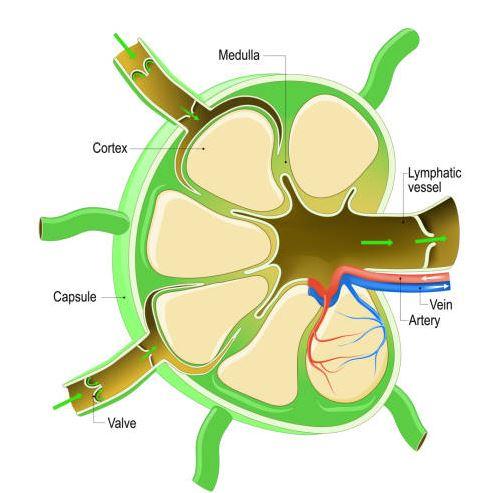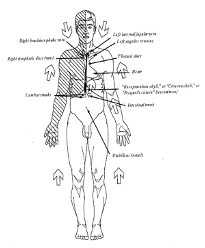
Hierarchy of Protection Mechanisms – LYMPH – stagnation

LYMPHATIC Normalization Techniques©
Andrew T. Still, DO said the body will protect different tissues in a Hierarchy of Importance.
1. Vascular, LYMPHATICS, and Fascia
2. Nervous System
3. Organs
4. Endocrine System
5. Musculo-skeletal System
Summary from Bruno Chikley, DO, Silent Waves
The lymphatic system is part of the circulatory system, running parallel to the venous blood supply and supporting the return of fluids to the heart through an amazing and complex network of capillaries and lymph vessels. The lymph system picks up the 10% fluid loss of the vascular system, and recycles/returns it back to the heart.
Important functions of the Lymph System:
1. It helps regulate the fluid balance in the body. It is a slow (5-8 contractions/minute for humans), low velocity and sensitive lower pressure fluid
system.
2. It facilitates the movement of immune cells from the periphery to the lymph nodes.
3. It absorbs cell waste products, such as lipoproteins and fat. Approximately 90% of the fluid that leaks from the blood circulation gets absorbed by
the lymphatics and circulated back in the blood supply.
Anatomy
The lymph vessel network starts in the periphery of the body with unique little, “feather-like” lymphatic capillaries. The capillaries are highly permeable and will absorb interstitial fluids with each contraction wherever they are located whether superficially under the dermis (skin) or deep in the fascia of muscles, tendons, viscera, periosteum, and even the dura matter in the brain. Thus, we find lymph capillaries under the skin creating the superficial lymph system. This superficial lymph network drains into larger lymph vessels, lymph nodes and then into trunks joining the deep circulation, eventually flowing back into the venous vascular system near the heart.
Lymphatic vessels have been found within the dural membranes of the Central Nervous System called the Glymphatic System within the past 10 years. Not only is the brain and spinal cord constantly cleansed by the rapid creation and absorption of the cerebral-spinal fluid, the glymphatic system flushes the brain at night. We know the CSF is in direct communication with the lymphatic system of the entire body. It is not very different than the nature of water. “There is no drop of water in the ocean, not even in the deepest parts of the abyss, that does not know and respond to the mysterious forces that created the tide.”

All but the smallest lymph vessels have a uniquely engineered valve system that allows the lymph to flow in only one direction. Each lymphatic vessel segment between valves is called a lymphangion. Lymphangions operate independently depending upon the amount of fluid present. Supported by the negative pressure in the lungs and in the heart, arterial contractions, the muscle pump action of exercise and the impact of ground force, approximately 1-3 liters of lymph per day flows back to the heart in a human.
Functions of the Lymph Nodes:
1. Filter and purify the lymph
2. Move lymph to the heart via rhythmic contractions
3. Concentrate the lymph
4. Return some fluid components to the venous system
5. Protein recycle system
6. Houses macrophages and phagocytes to defend the body from invading microorganisms
7. Produce and enable the maturation of T and B cells
DISTRIBUTION OF LYMPH
- 75% of the body’s superficial and deep lymph circulation (left side of head, left arm, left lung/heart, and everything under the diaphragm and both legs) terminates into the left subclavian vein through the left THORACIC DUCT.
- 25% of the body’s superficial and deep lymph circulation (right side of head, right arm, right lung/heart, and part of the superficial live drainage) will flow through the right TERMINAL DUCT in the right subclavian vein.
NSULTS to vascular and lymphatic vessels, lymph nodes and nerves include:
- Trauma: A chronic or sudden traction/shear or compression of the vessels or nodes
- Emotional or mental trauma
- Chemical, radiation or thermal irritants (toxicity)
- Electricity or EMF’s
In osteopathy, one core principle of the musculo-skeletal lsystem (hierarchy) is that muscles are “movers” or muscles are “protectors”. The area of the body with a loss of fascial glide in the lymph vessels or nodes will have increased tone in the affected area’s muscles and surrounding soft tissues. So, dysfunction of the lymphatic system will lead to restrictions in the musculo-skeletal system as the muscles “protect” around the lymphatic dysfunction!
Disturbances in the lymphatic compartment cause loss of lymph transport capability and leads to lymph stagnation and perhaps even local/global inflammation. Another point to keep in mind is that enlarged and dysfunctional nodes are often at a distance from the cause of the problem, such as an infected toe causing swelling of the popliteal lymph node at the knee.
Lymphatic Normalization Techniques (LyNT)©
Important principles of working with the lymphatics are:
- Understanding the applied anatomy of the lymphatics
- Diagnosis uses a method of palpation of strategic lymphatic structures, such as the spleen and thoracic duct, and lymph nodes in the body to determine which nodes, organs and tissues (e.g., musculo-skeletal) are dysfunctional. These lymphatic structures and lymph nodes may feel warm and painful to the touch or feel swollen or spongy (“boggy”) and there may be a tightness in the fascia around the lymphatic structures and nodes as well. All of these cause restriction in the body mechanics, often in a predictable pattern.

Diagnostic Dysfunctional Lymph Pattern
The EXAM usually shows:
1. Left FRONT shoulder tightness and diminished posterior glide
2. Right FRONT shoulder tightness and diminished posterior glide (sometimes)
3. SPLEEN tightness and diminished motility
4. Left DIAPHRAGM tightness – left side-bend of the body
5. Heat over SPLEEN (below the diaphragm)
6. Left DORSAL rotation of the ILIUM
7. Right DESCENDED sacrum
8. Left HIP tightness and diminshed glide/slide
9. Left KNEE and ANKLE tightness (fullness of fluid in leg [lymphedema])
10. General “bloating” and sluggish lymph motility of the body
Method of RESTORING function
The purpose of relieving the lymphatic stagnation is to help the body restore the pumping mechanism of the lymphangions and lymph nodes to aid in restoration of normal functions. This is accomplished using energetic techniques that employ the spleen (considered the master strategic lymphatic structure). When energetically connected to an area with lymphatic dysfunction, the spleen, as “the lymph node of the blood”, has the ability to open up the lymphatic restrictions by relaxing the spasms in the adventia layer of the affected lymphatic structures.
The fascial glide improves and the restrictions resolve quickly (since fasica conducts with the speed of sound!) and the pump mechanism kicks in. Within seconds, the lymph flow increases and seems to improve to approximately 80% of normal in the next 3-5 days. The remaining 20% will improve over the next month or two, depending on how severe the stagnation was before treatment.
ORGANS of Elimination
By restoring lymphatic flow, the body will use the following organs of elimination to remove toxins:
1. Skin – rashes, sores, itchy sites that last for a few days
2. Lungs – capillary oxygen exchange will release toxins into the lungs to be exhaled
3. Urine – Phase I liver detoxification moves water-based toxins to the kidneys for further filtering and toxin removal
4. Stool – Phase II liver detoxification will remove lipid-based toxins
Drinking enough water will help support the organs (skin and lungs) that also absorb toxins.
